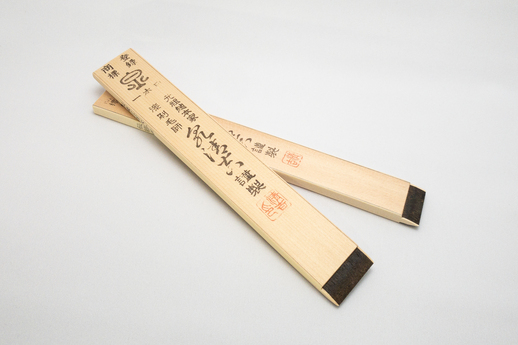2024.07.26
宙ちゃんの「伝統文化一直線」宙ちゃんの「伝統文化一直線」 第9回 技と美を支える道具たち
近藤宙時=日本伝統文化検定協会理事

泉清吉の漆刷毛(うるしばけ)
(https://www.torakichi-izumi.
信長が築いた岐阜城を頂く金華山を背に、毎年5月から10月まで長良川で行われる鵜(う)飼い。闇に近い藍色の空間を、だいだい色のかがり火をたいた流線型の鵜舟が夜空を映した清流を下っていく光景は、まさに日本人の原風景の一つです。ただ、この幻想的な夏の風物詩が、実はあすをも知れぬほど危うい技術伝承の上に成り立っていることに、いったいどれほどの観光客が思いをはせているでしょうか。
一子相伝で1300年以上も鵜飼いの技術をつないできた鵜匠の存在自体が奇跡的ですが、彼らが乗る鵜舟はそれ以上に存続が危ぶまれています。今、鵜舟を造れる人はわずかに1組の親子だけ。鵜匠が操るウミウは、蛇の目の連続模様が美しい竹編みの鵜籠に入れますが、これもつい最近まで1人しか作れる人がいませんでした。
私たちの目を楽しませてくれる伝統工芸品の幾つかは、たとえ工芸師が腕を振るいたくても、あすも必ず作られる保証はない状況に置かれています。経済産業省が指定した「伝統的工芸品」は、1974年に制定された伝統的工芸品産業の振興に関する法律(伝産法)によって振興事業が行われています。しかしながら、対象となる工芸品を定義した同法第2条第1項1号には「主として日常生活の用に供されるものであること」とあるため、日常生活の用に供されない日本刀はもちろんのこと、制作に用いる伝統的な道具たちも国による振興策から除外されてきました。
例えば春慶塗(しゅんけいぬり)など、透き通る漆をはけ目も残さず鏡面のように塗るための漆ばけ。日本髪を結うときに使う「かもじ」(人毛で作った付け毛)の中でも、年数を経て脂分が抜けた古かもじを麦漆で固め、100年以上たった狂いの出ないヒノキの板で挟んだものです。普通のはけとは違い、毛が鉛筆のように板の末端まで通っており、必要に応じて板を削いで使います。人に見られることがない道具とあって何の装飾もありませんが、研ぎ澄まされた手仕事の気品が匂い立つような存在感。漆職人に使われ続けて短くなった漆ばけにも、長い間信頼され、愛され続けてきた物のみが持つ、誇らしげな凛(りん)とした風格があります。
また、和紙をすく時、すき舟(水槽)の中を前後左右に揺すられる簾桁(すけた)に挟まれた、極繊細な竹ひごを生糸で編んだ簾。とりわけ、カゲロウの羽に例えられる土佐典具帖紙(とさてんぐじょうし)をすくための簾の整然としたたたずまいは、美しさを誇るものではないだけに、ひそやかな可憐(かれん)ささえ感じさせます。
日本語には「縁の下の力持ち」という奥深い言葉があります。「いただきます」や「ごちそうさま」と同様、見えないものにも心を通わせる細やかな気遣いがにじみ出た表現です。伝統工芸の継承に欠かせない「縁の下の力持ち」である道具たちにも多くの人が心を寄せ、それらを駆使して生み出される匠の技と美にいつまでも触れられることを願ってやみません。
カテゴリー: 宙ちゃんの「伝統文化一直線」
関連タグ: #木漆工





